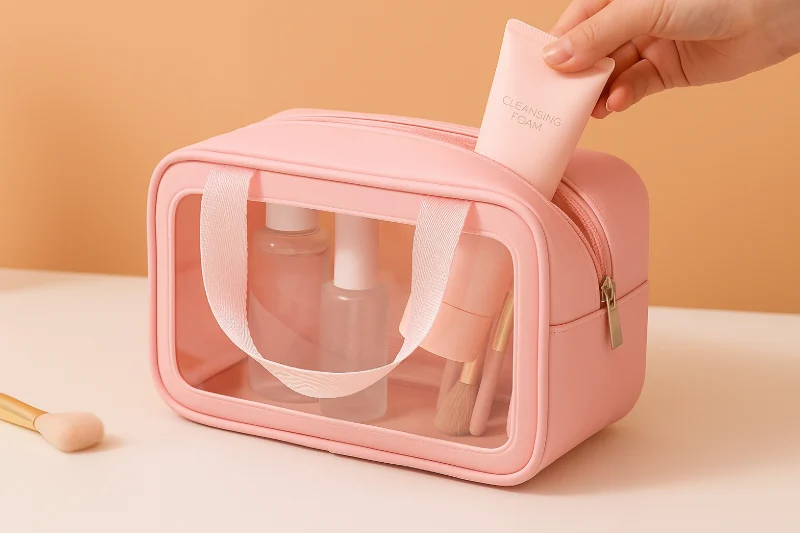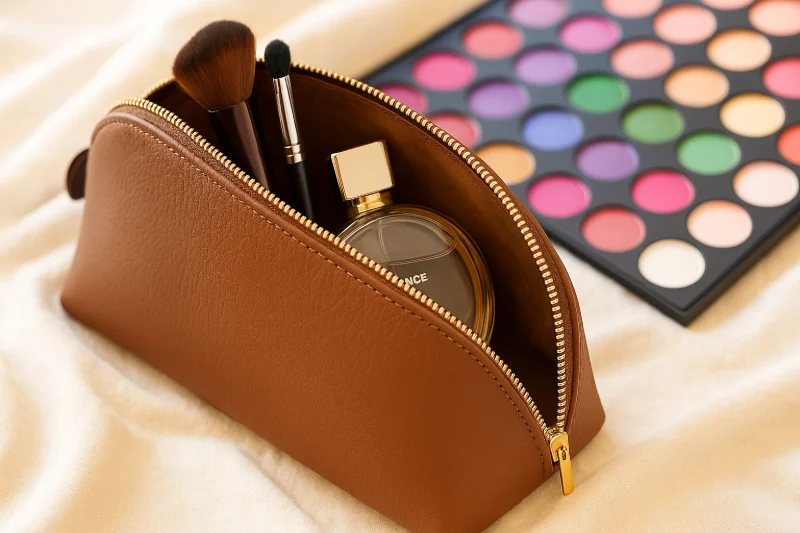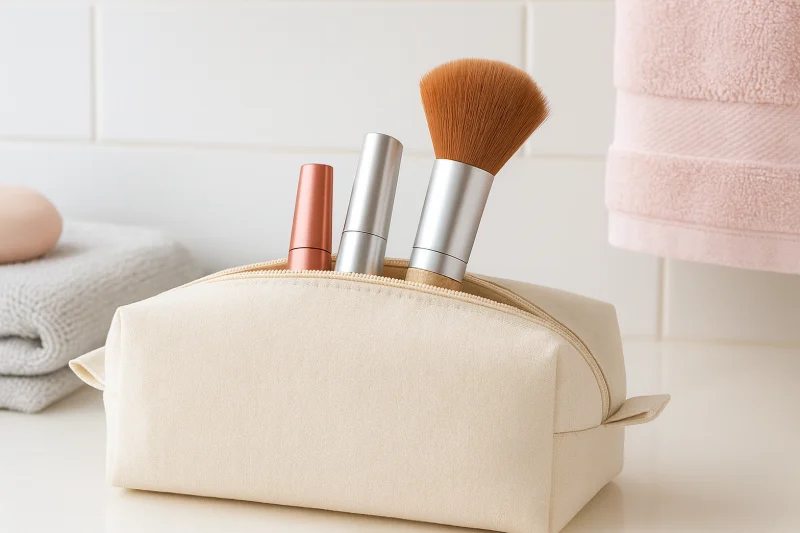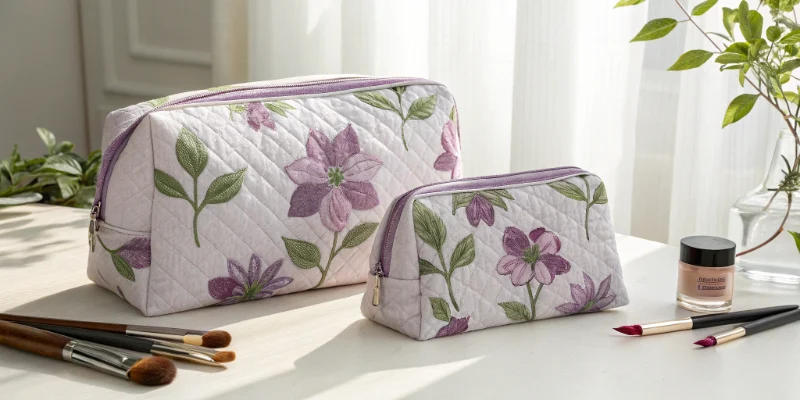
In supply chain and product development, makeup bags and toiletry bags are often grouped together as “travel pouches.” But from the end user’s view, they are quite different in purpose, size, material, and design. For brands and buyers, knowing the difference not only reduces communication costs but also helps with product positioning and marketing.
What is the difference between a makeup bag and a toiletry bag? A makeup bag is mainly used to store cosmetics and beauty tools. It is smaller, often has compartments, brush slots, and soft lining, with a focus on look and detail. A toiletry bag is better for holding toothbrushes, shampoo, razors, and other personal care items. It is larger, often has a big opening or a hanging design, and uses waterproof, durable materials. The first is better for daily use and touch-ups, while the second is more useful for travel, overnight stays, or the gym.
While the main differences between makeup bags and toiletry bags have been outlined, truly understanding how they affect daily use requires a closer look at naming, usage scenarios, capacity, structure, and materials. Keep reading to gain clearer insights and make smarter choices for selection or product development.
Cosmetic bag and makeup bag are often used interchangeably. True
Both terms refer to small pouches used to store makeup and beauty tools, especially for travel or everyday use.
Only women use makeup bags. False
Men also use makeup or grooming bags, especially in the form of Dopp kits or travel organizers.
A cosmetic bag is meant for makeup and beauty tools, such as lipsticks, foundation, eyeshadow palettes, and brushes. Compared with a toiletry bag, its shapes are more flexible: from small handheld pouches to multi-layer vanity cases. The design pays more attention to compartments and protective lining, making sure makeup products are not squeezed or broken.
The TSA clear liquid bag often seen during travel is not the same as a toiletry bag or a cosmetic bag. It is only an extra pouch made for airport security checks. It is usually used together with a toiletry bag, but it does not replace its storage and organizing function.

In daily commuting or situations that require carrying makeup for touch-ups, a cosmetic bag is more suitable. It is small and easy to put in a handbag or backpack. The common brush slots and small compartments can hold frequently used items in place, preventing lipstick, powder, and brushes from rubbing against each other or staining other belongings.
For one- to two-day short trips or business travel, a toiletry bag is the main choice. Users usually need a compartmentalized structure and waterproof lining to store shampoo, shower gel, razor, and skincare separately. This not only prevents liquid leakage but also makes packing easier.
In scenarios where more items need to be carried and there is frequent movement, a toiletry bag has clearer advantages. Common designs with hanging hooks, full-opening structures, and wipeable linings make items visible at a glance and easy to access, keeping them clean in hotel bathrooms, gyms, or outdoor camping environments.
In gift sets or retail packages, the difference between the two lies mainly in material and appearance. High-end skincare products are often paired with toiletry bags made of leather or woven textures, highlighting practicality and quality. Makeup sets, on the other hand, are more likely to come with cosmetic bags that feature strong design sense, emphasizing fashion and brand style.
Most toiletry bags use a single large compartment with a wide opening. This design makes it easy to pack and store bulkier bottles or grooming items. The advantage is large capacity and easy cleaning, but it’s less suitable for small or fragile items.
Cosmetic bags often emphasize multiple compartments or layers, allowing items like lipsticks, foundations, eyeshadow palettes, and brushes to be stored separately. This prevents mixing between powders and liquids, and makes products easier to find.
Some toiletry bags come with hooks, so they can be unfolded and hung in bathrooms or gyms. Inside, they often feature clear or mesh pockets, keeping everything visible at a glance. This design adds convenience during travel or outdoor use.
Cosmetic bags often include brush slots, elastic bands, or small pockets for holding makeup brushes, pencils, or lipsticks. These features prevent items from scattering or getting dirty.

Focuses more on keeping small cosmetic items well organized. Common features include brush slots, elastic straps, or small compartments to separate items, ensuring products do not rub against each other and can be accessed quickly.
Prioritizes safe storage of liquids and bottles. Detachable pouches, transparent bags, or mesh pockets are more common, making it easier to separate shampoo, body wash, and other liquid items, and allowing them to be taken out directly during security checks.
The opening designs of the two also differ:
Toiletry Bag: Often uses U-shaped zippers or full-opening designs, making it easier to pack large items and clean quickly.
Cosmetic Bag: Often uses smaller two-way zippers or portable flip covers, making it convenient for touch-ups on the go.
In terms of materials, the distinction between toiletry bags and cosmetic bags is also clear: toiletry bags emphasize function and durability, while cosmetic bags focus more on appearance and texture.
Nylon, polyester, or oxford fabric: lightweight, durable, and easy to clean, often used in travel toiletry bags. In most cases, the back side of these fabrics is coated with PU, TPU, or PVC to provide water resistance and leak protection.
TPU, PVC, or PEVA (transparent or semi-transparent): often used as the main body or inner layer. These materials are waterproof, easy to wipe clean, and suitable for liquid separation or fully transparent designs.
The main advantage of toiletry bags lies in their durability, waterproof function, and ease of cleaning, especially in humid environments or when carrying liquids.
Cotton, canvas, satin, or linen-like fabrics: versatile in style, suitable for prints, color blocking, or product series.
Velvet, embossed cotton, or specialty fabrics: offer a more premium look and feel, often used in gift sets or themed collaborations.
PU, faux leather, or textured alternatives: structured, neat, and easy to maintain, widely used in urban or business-style cosmetic bags.
Cosmetic bags place more weight on appearance, texture, and brand expression. In many cases, the choice of material reflects aesthetic value as well as marketing needs.
Toiletry bags: the so-called “waterproof lining” is usually just a PU, TPU, or PVC coating on the back of the main fabric, rather than a separate sewn lining. Some higher-end models use an independent PEVA or PVC inner layer, which can be removed for cleaning and works well for liquid separation.
Cosmetic bags: more likely to feature independent linings such as taffeta, knit fabric, microfiber, or quilted fabrics. These linings improve the touch and provide cushioning, helping to protect makeup palettes or brushes.
Key difference: toiletry bags are designed around waterproofing and leak protection, while cosmetic bags focus on delicate protection.
B2B tip: when clients mention “lining,” confirm whether they mean a separate sewn lining or a fabric back coating, since the two differ greatly in both process and cost.
| Category | Toiletry Bag / Dopp Kit | Cosmetic Bag / Makeup Pouch |
|---|---|---|
| Common Materials | Nylon / polyester / oxford fabric (back coating PU/TPU/PVC); TPU / PVC / PEVA transparent material | Cotton / canvas / satin / linen-like; velvet / embossed cotton; PU / faux leather / textured alternatives |
| Key Features | Durable, waterproof, easy to clean; suitable for liquids and toiletry items | Various textures, stylish appearance; good for brand collections and gift sets |
| Lining Treatment | Mostly fabric back coating to form a waterproof layer; some premium models use independent PEVA / PVC inner liner | Usually independent linings (taffeta, knit fabric, microfiber, quilted fabric) for better touch and cushioning |
| Design Focus | Function first: waterproof, leak-proof, easy to wipe, suited for humid conditions | Appearance first: quality, colors, patterns, more aligned with brand positioning |
Dopp kits were originally designed for men’s toiletries. True
The term 'Dopp kit' originated in the early 20th century and was associated with men's grooming kits for travel.
Makeup pouches are always rectangular and boxy. False
Makeup bags come in a wide variety of shapes, including dome, cylinder, and flat styles.
Cosmetic bags and toiletry bags are both types of travel organizers, but they serve different purposes and design focuses. Toiletry bags emphasize capacity, waterproofing, and durability, making them ideal for storing liquids and personal care products. Cosmetic bags focus more on compartments, lining, and appearance, making them better suited for makeup and small tools. For end users, knowing the difference avoids inconvenience; for brands and buyers, clear positioning helps with product development and marketing.
If you are looking for a reliable custom cosmetic bag or toiletry bag manufacturer, Yanxin Bag can provide you with one-stop custom solutions. We support a wide range of materials, structures, and printing methods, and can mass-produce custom toiletry bags and custom cosmetic bags that match your brand positioning—helping you add value in gifting, retail, or promotional scenarios. Contact us today to make your product line more distinctive and competitive in the market.

Answer: Besides “makeup bag”, other frequently used terms include “cosmetic bag”, “makeup pouch”, “toiletry bag”, “vanity case”, and “Dopp kit”. Each term may imply slightly different usage or design features.
Answer: The main difference lies in their function and design—toiletry bags emphasize capacity, waterproofing, and durability for holding liquids and personal care items, while cosmetic bags prioritize compartments, soft lining, and stylish appearance for makeup and small tools.
Answer: Toiletry bags typically use durable, water-resistant materials like nylon, polyester, Oxford fabric with PU/TPU/PVC coatings, and sometimes transparent TPU, PVC, or PEVA.
Answer: Hanging designs enhance convenience in travel or shared spaces—users can hang the bag in bathrooms or gyms for easy access and visibility.
Answer: Choose a cosmetic bag when you need to organize makeup and beauty tools neatly with small compartments and padding for delicate items—especially for daily touch-ups or commute use.
Answer: While they can be used interchangeably, it’s not ideal. Toiletry bags are better for liquid and hygiene items, whereas cosmetic bags are designed to protect and organize beauty products—using them as intended avoids spills and damage.
Answer: They recommend padded cases with detachable or hanging pockets, waterproof materials, and clear or organized compartments for easy access and protection.
Answer: In English, “toiletry bag” can also be called a “Dopp Kit,” “bathroom bag,” “travel kit,” “amenity kit,” or “wash kit”—all referring to portable pouches for hygiene supplies.

Order or no-order we are Always here to help you!
We will contact you within 1 working day, please pay attention to the email with the suffix “@yanxinbag.com”.
Order or no-order we are Always here to help you!
We will contact you within 1 working day, please pay attention to the email with the suffix “@yanxinbag.com”.